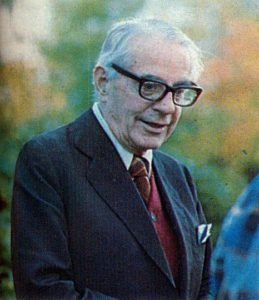In addition to being a legendary mushroom expert, Robert Gordon Wasson was an author and Vice President for Public Relations at JP Morgan & Company.1 He studied at the Columbia School of Journalism and then the London School of Economics after receiving the first Pulitzer Traveling Scholarship. After teaching English at Columbia University from 1921-22, he became a reporter for the New Haven (Connecticut) Register. By 1925, he was living in New York City and writing a financial column for the New York Herald Tribune. Wasson joined the JP Morgan Company in 1934 where he pioneered the field of banking public relations. He served as vice president from 1943-1963 when he retired.
Wasson’s introduction to mushrooms came from his wife Valentina Pavlovna Guercken. On their honeymoon in New York’s Catskill Mountains in 1927, Valentina found mushrooms similar to the ones she had known in her native Russia. This discovery sparked both their interest and they went on to study and incorporate mycology with other disciplines such as religion, art, history, and linguistics.
Beginning in 1953, Wasson and his wife led expeditions to Mexico to research the religious use of mushrooms by the native people. It was here the Wassons were the first to witness a mushroom velada (session) and during a later visit, participate in a velada led by Maria Sabina. Even after Valentina’s death in 1958, Wasson continued to take yearly trips to Mexico until 1962. Over the years, Wasson and botanist Roger Heim collected and identified several species of Psilocybe mushroom and others in the family Strophariaceae. They sent samples of mushrooms to Albert Hofmann who was working at Sandoz Laboratories in Switzerland. Using this material, Hofmann was able to isolate and identify the compounds psilocybin and psilocin.
Wasson coined the term ‘magic mushroom’ in a 1957 article in LIFE magazine.2 The article detailed his experiences in the veladas and resulted in people searching the wooded mountain areas in Mexico for mushrooms.
In the 1960s, Wasson and his research colleagues created the term entheogen to replace words like ‘psychedelic,’ ‘hallucinogenic,’ and ‘drug’ that were commonly used at the time to describe mind-altering plants and chemicals that produce a ‘divine’ experience. Also during this decade, Wasson traveled extensively throughout the Far East researching the true identity of the Indian soma plant which he thought to be the fly-agaric mushroom Amanita muscaria. He published his findings in a 1967 work titled, Soma: Divine Mushroom of Immortality.
Wasson also studied the Greek Eleusinian Mysteries, an initiation ceremony used by the ancient Greek cult of Demeter and Persephone. It was hypothesized by Terence McKenna that psilocybin mushrooms were used in these ceremonies. The mushrooms may have been added to a potion called kykeon which was drunk at a pivotal point in the ceremony. Wasson and his colleagues theorized that the potion contained ergot fungus with psychoactive alkaloids such as LSD. In 1978, Wasson co-authored a book on this work with Albert Hofmann and Carl Ruck titled The Road to Eleusis: Unveiling the Secret of the Mysteries.
Wasson’s impact on the field of mycology and psychedelic mushrooms was so great that two species have been named in his honor: Psilocybe Wassonii Heim and Psilocybe Wassonorum Guzman.
A list of Wasson’s books, articles, and writings is found on Erowid.

